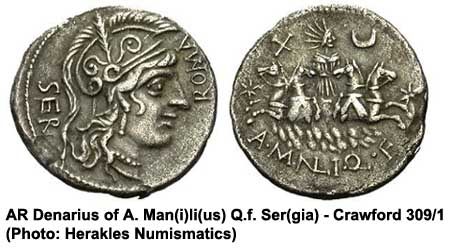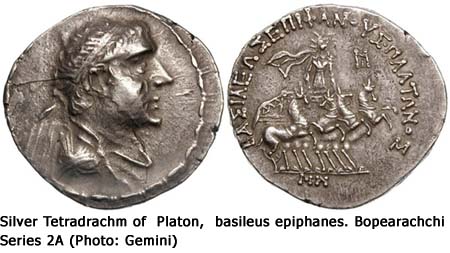 There is a problem with the abbreviated clan name, and therefore basic identity, of the Roman mint magistrate responsible for Crawford's type 377: a small issue of denarii serrati, struck around 80 B.C. with an unusually spectacular reverse design of Zeus' taurus conveying Europa from Tyre to Crete. Crawford presents the legend as L. VOL L.F STRAB (RRC, 391), apparently following a scholarly consensus. Opinion has divided whether to resolve VOL as Vol(teius) or Vol(umnius), neatly demonstrated in the Pauly encyclopedia of all things ancient and classical, where the same mint master has separate articles under the two nomina, by the same author (Hans Gundel), who emphasized the uncertainty1. Earlier and especially numismatic scholarship preferred Volteius (Mommsen RMW 1860, Babelon 1885 and Grueber 1910, also followed by Sydenham 1952). The historian Cichorius, in an influential study of the command staff of Pompeius Strabo, opted for Volumnius (a name of senators in the Ciceronian age) and in particular for a son of L. Volumnius L. f. in the Aniensis tribe2. The argument is a good one. Good enough for Badian to endorse it and rebuke Sydenham for persisting with the tradition of Volteius3. Cichorius followed Babelon's placement of the type (ca.60 B.C.), while Sydenham preferred Grueber's significantly lower date. Since Grueber the numismatists have stuck to the Sullan period range 82/79 B.C., rightly according to the hoard indications (cf. RRC, 75-82, with Table XII) and the mule with Q. Antonius Balbus obverse (Grueber 1910/70, 1.385 n.2). This improves Cichorius' case further by permitting L. Vol. L. f. Strabo to be identified directly with L. Volumnius L. f. on the Pompeian command council, as urged by Badian and accepted by Crawford (RRC, 391: “probably”), citing Cichorius and T. P. Wiseman (the latter's joint 1964 NC article with Crawford on the Sullan period coinage). Although in his later work on the novi homines Wiseman reverted to Gundel's more cautious approach4. There is a problem with the abbreviated clan name, and therefore basic identity, of the Roman mint magistrate responsible for Crawford's type 377: a small issue of denarii serrati, struck around 80 B.C. with an unusually spectacular reverse design of Zeus' taurus conveying Europa from Tyre to Crete. Crawford presents the legend as L. VOL L.F STRAB (RRC, 391), apparently following a scholarly consensus. Opinion has divided whether to resolve VOL as Vol(teius) or Vol(umnius), neatly demonstrated in the Pauly encyclopedia of all things ancient and classical, where the same mint master has separate articles under the two nomina, by the same author (Hans Gundel), who emphasized the uncertainty1. Earlier and especially numismatic scholarship preferred Volteius (Mommsen RMW 1860, Babelon 1885 and Grueber 1910, also followed by Sydenham 1952). The historian Cichorius, in an influential study of the command staff of Pompeius Strabo, opted for Volumnius (a name of senators in the Ciceronian age) and in particular for a son of L. Volumnius L. f. in the Aniensis tribe2. The argument is a good one. Good enough for Badian to endorse it and rebuke Sydenham for persisting with the tradition of Volteius3. Cichorius followed Babelon's placement of the type (ca.60 B.C.), while Sydenham preferred Grueber's significantly lower date. Since Grueber the numismatists have stuck to the Sullan period range 82/79 B.C., rightly according to the hoard indications (cf. RRC, 75-82, with Table XII) and the mule with Q. Antonius Balbus obverse (Grueber 1910/70, 1.385 n.2). This improves Cichorius' case further by permitting L. Vol. L. f. Strabo to be identified directly with L. Volumnius L. f. on the Pompeian command council, as urged by Badian and accepted by Crawford (RRC, 391: “probably”), citing Cichorius and T. P. Wiseman (the latter's joint 1964 NC article with Crawford on the Sullan period coinage). Although in his later work on the novi homines Wiseman reverted to Gundel's more cautious approach4.
A point worth slipping into this controversy is that the nomen abbreviation VOL, ever printed in modern texts, is not in the legends on the coins. Between the puncts separating the L. forename from the L. F. filiation appears a monogram followed by O. The monogram is a Y with right bar at the base. VOL can only be extracted by taking the monogram as a V over L and reading anagramatically left to right from the top (VO) then back to the monogram again to fetch the L. Such an abnormal procedure should be resisted unless absolutely necessary. It isn't. The cognomen STRAB(o) of the same legend bunches the TR and AB as monograms, with all letters to be read sequentially left to right. In justification of reading the nomen monogram as V over L, the R of the TR monogram also appears shortly but distinctly below the top bar of the T. Perhaps the strangeness of VLO, and problems perceived in resolving it, provoked the strong preference for VOL in scholarly texts. Perhaps tralaticious inadvertence5. In any case, it would be better to focus on the nature of monograms, according to which the desired vowel can be found in the downstroke of the Y (or L), namely iota.
 In this regard we may reconsider the form of the “Manlius” nomen on the Crawford type 309 denarii which feature Sol (Grk. Helios). Prosopographic and palaeographic considerations urge the identification of this earlier mint magistrate as an Aulus Manilius, rather than Manlius. Firstly, the appearance of the nomen of Marius' legatus in Pliny (HN 33.21) with the rarer form Manilius. Seconded by some notable epigraphic evidence from Kos in the Julio-Claudian period, when two Auli Manili held the annual priesthood of the Apolline temple at Halasarna (in A.D. 56 and 64 - IGR IV 1101). Religious associations were hardly less enduring than onomastic in antiquity. Rhodes and Kos are an important nexus for the Hellenistic cult of Helios and the origins of the Apollodotid branch of the somewhat neglected Indo-Greek dynasties. Besides the name and significance of Apollodotos I Soter himself, the numismatically famous (but rare) name Heliokles seems to have first been formulated in the far eastern Hellenistic dominions. Koan coinage struck around 200 B.C. has even turned up in the Rawalpindi markets6, while Helios charioteer appears on tetradrachms of the In this regard we may reconsider the form of the “Manlius” nomen on the Crawford type 309 denarii which feature Sol (Grk. Helios). Prosopographic and palaeographic considerations urge the identification of this earlier mint magistrate as an Aulus Manilius, rather than Manlius. Firstly, the appearance of the nomen of Marius' legatus in Pliny (HN 33.21) with the rarer form Manilius. Seconded by some notable epigraphic evidence from Kos in the Julio-Claudian period, when two Auli Manili held the annual priesthood of the Apolline temple at Halasarna (in A.D. 56 and 64 - IGR IV 1101). Religious associations were hardly less enduring than onomastic in antiquity. Rhodes and Kos are an important nexus for the Hellenistic cult of Helios and the origins of the Apollodotid branch of the somewhat neglected Indo-Greek dynasties. Besides the name and significance of Apollodotos I Soter himself, the numismatically famous (but rare) name Heliokles seems to have first been formulated in the far eastern Hellenistic dominions. Koan coinage struck around 200 B.C. has even turned up in the Rawalpindi markets6, while Helios charioteer appears on tetradrachms of the  Bactrian basileus epiphanes Platon (late 140s B.C.), in similar style to Sol charioteer on the type 309 Roman coinage (late 120s B.C.). Hence it is plausible to suppose that the common forename and nomen of the Manilian priests of Kos sprang from the household of the type 309 mint master. The latter's nomen appears in his legends as sequential MA and NL monograms followed by a terminal iota. The nature of monograms permits the downstroke of the L (which doubles as the second upstroke of the N) to triple as an iota, allowing the assumed NL monogram to be read NIL, and the nomen as MANILI(us). Bactrian basileus epiphanes Platon (late 140s B.C.), in similar style to Sol charioteer on the type 309 Roman coinage (late 120s B.C.). Hence it is plausible to suppose that the common forename and nomen of the Manilian priests of Kos sprang from the household of the type 309 mint master. The latter's nomen appears in his legends as sequential MA and NL monograms followed by a terminal iota. The nature of monograms permits the downstroke of the L (which doubles as the second upstroke of the N) to triple as an iota, allowing the assumed NL monogram to be read NIL, and the nomen as MANILI(us).
The same approach would render the nomen abbreviation of the type 377 legends as VILO. That is readily resolved from the onomastic resources in the great collections of Roman epigraphs. Vilonius. An unusual nomen to be sure, but well attested by inscriptions, spread out along a geographic trail from the Venetia to Rome, via Picenum and Umbria. The tituli of the Viloni include the forename Lucius, perhaps most interestingly in the case of L. Vilonius M. f. Lucullus of Concordia (mod. Portogruaro) in the Venetia (CIL V 1949). But more significant for the identity of Crawford's type 377 mint magistrate is the freedman L. Vilonius Tityirus from the Via Sacra in Rome (CIL VI 9419). The same text attesting his name and status gives his position as a flaturarius. In other words, an employee of the Rome mint involved directly in coinage manufacture.
However one prefers to interpret the unusually abbreviated rendering of the nomen gentilicium on the 377 type, none of Volteius, Volumnius or Vilonius were particularly eminent or numerous among office holders in Sulla's day. The nomen could easily have been clarified at the expense of the filiation, and even the cognomen. This raises important questions for Roman numismatic and prosopographic studies, and their interrelationship. Did the mint magistrates include filiation to distinguish themselves from contemporary homonyms in public life, or just to conform with current mint fashion? Perhaps both, from time to time.
1 RE (Paulys Realencyclopädie der classischen Altertumswissenschaft) 2nd series, 17 (1961) s. v. Volumnius (14), col.882, and Volteius (4), col.849: “The legend of his coins exhibits only L. VOL. L. F. STRABO”.
2 Conrad Cichorius Römische Studien (Teubner, 1922), 150ff. The consilium, before Asculum in autumn 89 B.C., is documented and dated epigraphically - A. Degrassi (ed.) ILLRP 515. Grueber (1910/70, 1.385) was not entirely happy with Volteius, pointing out Vol.-resolution alternatives: Volcatius, Volumnius and Volusius. But he settled for Volteius in his text, and the general index (3.231).
3 E. Badian, Historia 12 (1963) 142: “[Sydenham] is here, as usual, unaware of studies in Roman history.”
4 New Men in the Roman Senate 139 B.C.- A.D.14 (Oxford, 1971), 283, no.562, citing Gundel's RE Volteius 4 and Badian for Volumnius (while ignoring Gundel's RE Volumnius 14) and including the mint magistrate in his supplementary list reserved for incerta nomina as: L. VOL. L. f. STRABO.
5 The resolution Volteius preferred by numismatists goes back to Orsini (1577: L. VOLTEIVS L.F. STRABO), via Echkel (1792-1828: Volteia, L. VOL. L.F. STRAB) and Augustin (1592, “L. Volteio” in the index). My thanks to Andrew McCabe for these references. Andrew's website devoted to the Republican coinage is exceptional for representing the nomen VLO:
http://andrewmccabe.ancients.info
Other modern texts which content themselves with VOL include the standard work on the Republican magistrates, MRR 2.456 (1952) and MRR 3.224 (1986). In the later volume Broughton also cites a comprehensive re-examination of ILLRP 515 favouring the assimilation of L. Volumnius L. f. Ani. with L. Vol. L. f. Strabo - N. Criniti, L'Epigrafe di Asculum di Gn. Pompeo Strabone (Milan, 1970), 113-14.
6 See P. L. Gupta “The Greek hemidrachm in Jodhpur Museum”, in Devendra Handa (ed.) Oriental Numismatic Studies 2 (New Delhi, 1999), 13-16. |